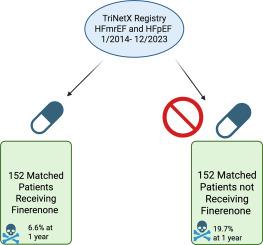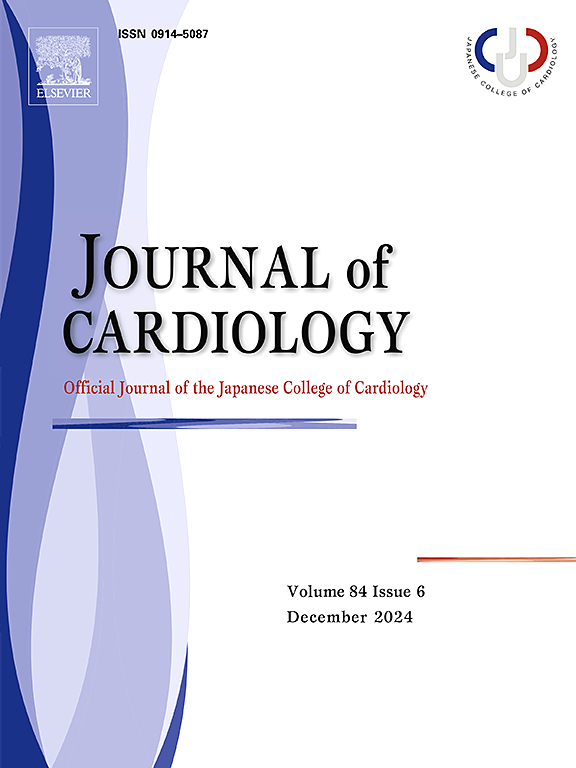Finerenone and cardiovascular outcomes in heart failure with mildly reduced and preserved ejection fraction: A propensity-matched analysis
IF 2.6
3区 医学
Q2 CARDIAC & CARDIOVASCULAR SYSTEMS
引用次数: 0
Abstract
Background
Heart failure with preserved and mildly reduced ejection fraction (HFpEF/HFmrEF) lacks effective therapies. Finerenone, a non-steroidal mineralocorticoid receptor antagonist, may offer cardiovascular benefits in this population.
Methods
We conducted a retrospective, propensity-matched cohort study using the TriNetX network to compare outcomes in HFpEF/HFmrEF patients treated with finerenone versus no MRA. Primary outcomes included all-cause mortality, acute heart failure hospitalization, and major adverse cardiovascular events (MACE).
Results
Among 304 matched patients (n = 152 per group), finerenone was associated with significantly lower 1-year mortality (6.6 % vs. 19.7 %, HR 0.24, p = 0.001) and heart failure hospitalization (10.5 % vs. 21.7 %, HR 0.47, p = 0.01). MACE was also reduced at 1 year (35.5 % vs. 47.4 %, HR 0.67, p = 0.022).
Conclusion
Finerenone use was linked to improved short-term cardiovascular outcomes in patients with HFpEF and HFmrEF, supporting its potential role in this highrisk population.

芬烯酮与心力衰竭伴轻度射血分数降低和保留的心血管结局:倾向匹配分析。
背景:保留和轻度降低射血分数的心力衰竭(HFpEF/HFmrEF)缺乏有效的治疗方法。非甾体矿物皮质激素受体拮抗剂芬烯酮可能对这类人群的心血管有益。方法:我们使用TriNetX网络进行了一项回顾性、倾向匹配的队列研究,以比较使用细芬烯酮和未使用MRA治疗的HFpEF/HFmrEF患者的结果。主要结局包括全因死亡率、急性心力衰竭住院和主要不良心血管事件(MACE)。匹配结果:304名患者(每组)152 n = finerenone与死亡率显著降低1年(6.6 % 19.7 vs %,人力资源0.24,p = 0.001)和心脏衰竭住院(10.5 % 21.7 vs %,人力资源0.47,p = 0.01)。MACE在1 年时也有所降低(35.5% % vs. 47.4 %,HR 0.67, p = 0.022)。结论:芬尼酮的使用与HFpEF和HFmrEF患者的短期心血管预后改善有关,支持其在这一高危人群中的潜在作用。
本文章由计算机程序翻译,如有差异,请以英文原文为准。
求助全文
约1分钟内获得全文
求助全文
来源期刊

Journal of cardiology
CARDIAC & CARDIOVASCULAR SYSTEMS-
CiteScore
4.90
自引率
8.00%
发文量
202
审稿时长
29 days
期刊介绍:
The official journal of the Japanese College of Cardiology is an international, English language, peer-reviewed journal publishing the latest findings in cardiovascular medicine. Journal of Cardiology (JC) aims to publish the highest-quality material covering original basic and clinical research on all aspects of cardiovascular disease. Topics covered include ischemic heart disease, cardiomyopathy, valvular heart disease, vascular disease, hypertension, arrhythmia, congenital heart disease, pharmacological and non-pharmacological treatment, new diagnostic techniques, and cardiovascular imaging. JC also publishes a selection of review articles, clinical trials, short communications, and important messages and letters to the editor.
 求助内容:
求助内容: 应助结果提醒方式:
应助结果提醒方式:


